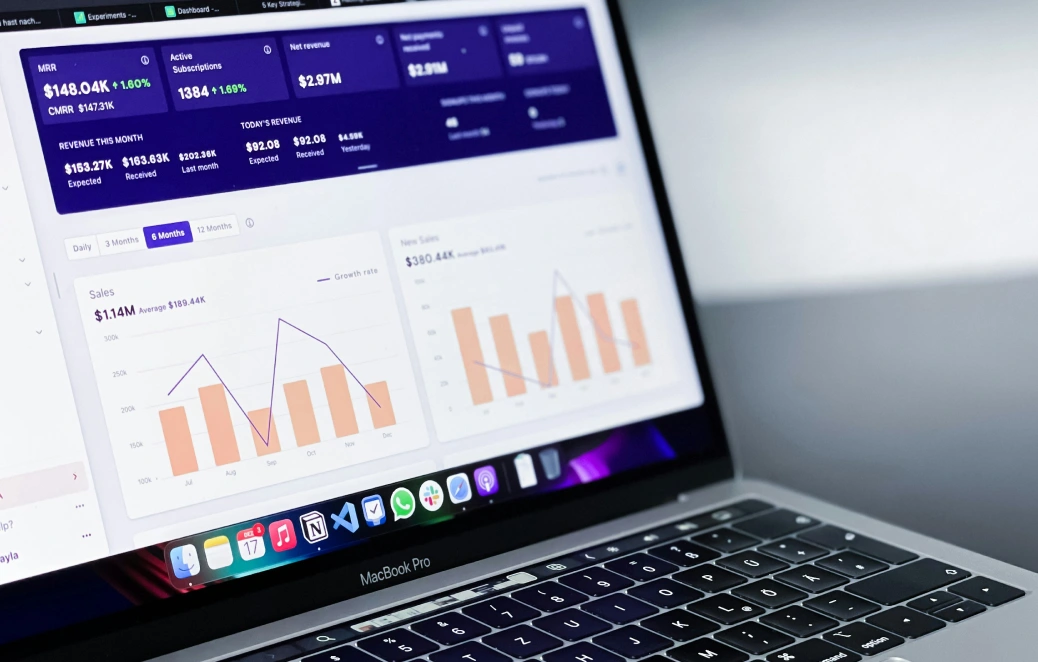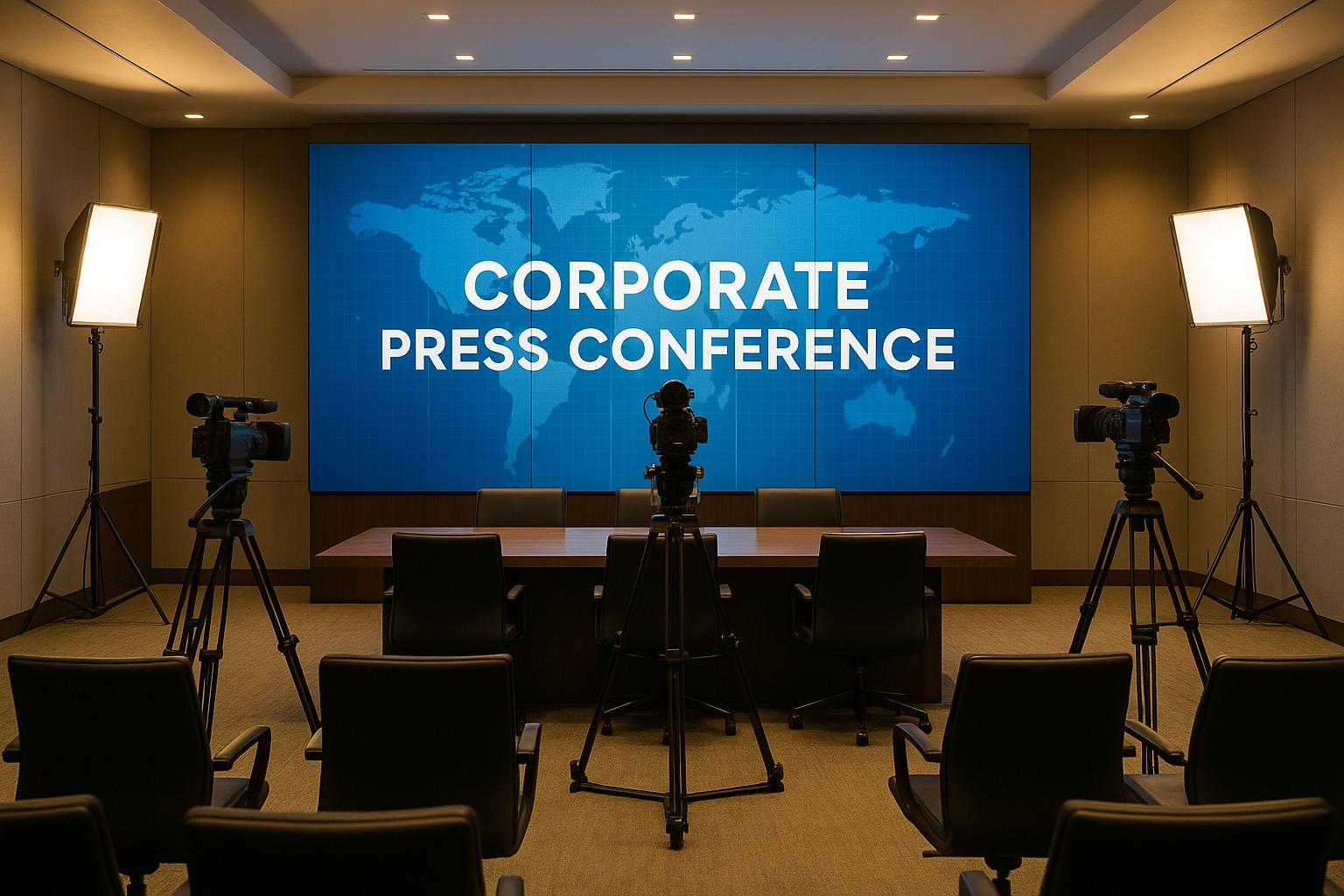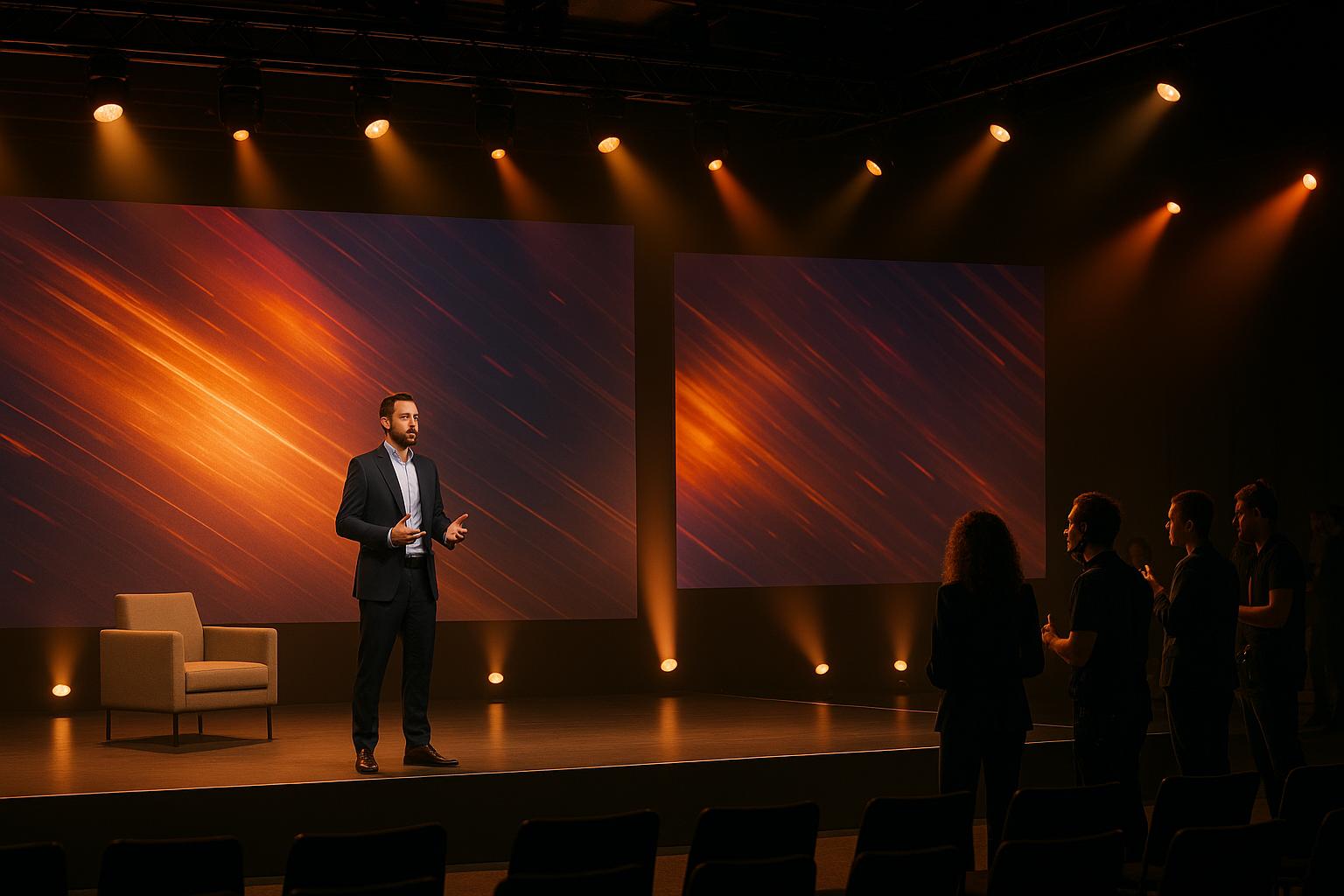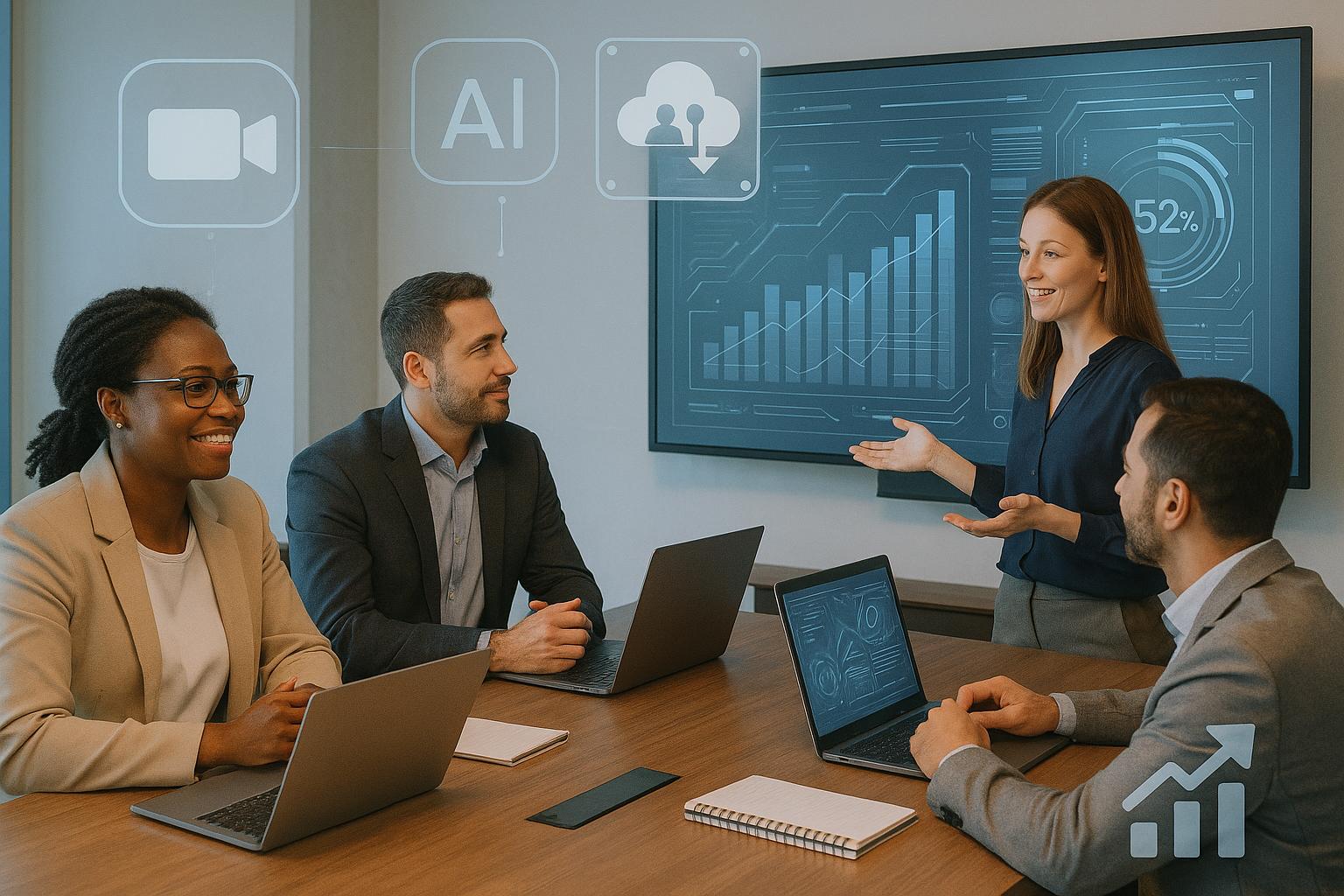Guide To Create A High-impact Corporate Sales Conference

Chief Executive Officer
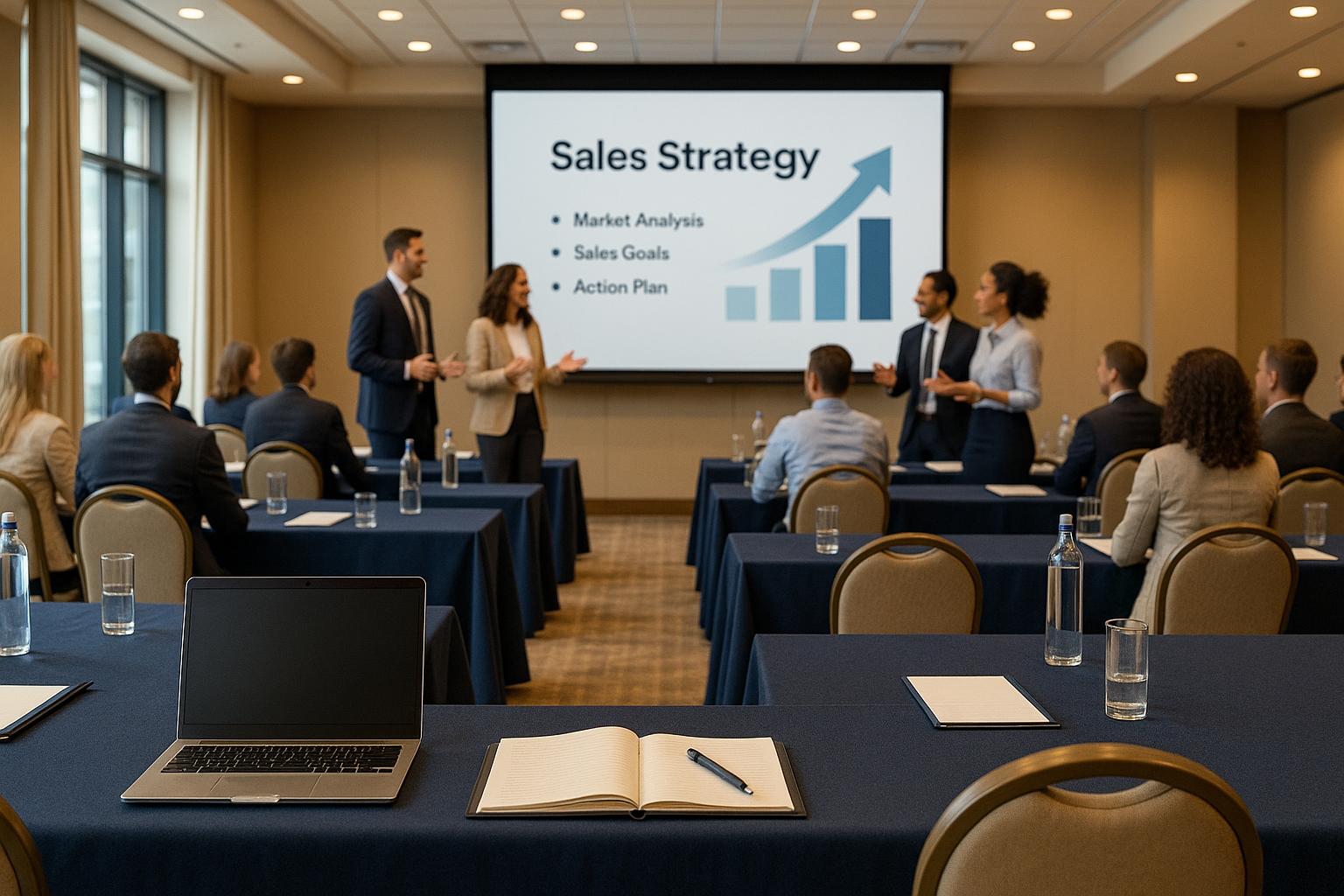
Organizing a corporate sales conference requires clear goals, smart budgeting, and engaging content to ensure success. A well-planned event boosts team morale, improves skills, and drives measurable results. Here's how to make it work:
- Set measurable goals: Focus on KPIs like revenue growth or lead conversion rates.
- Plan your budget: Account for venue, AV setup, catering, and staffing while including a buffer for unexpected costs.
- Understand your audience: Tailor sessions to different roles and experience levels using surveys.
- Create an engaging agenda: Mix keynotes, breakout sessions, and interactive formats like workshops or role-playing.
- Leverage technology: Use high-quality AV equipment and AI tools to enhance the experience.
- Ensure smooth logistics: Choose accessible venues, meet safety standards, and coordinate across teams.
Go behind the scenes how to plan a successful conference
Planning and Setting Clear Goals
A successful corporate sales conference starts with a solid foundation: clear, actionable goals that align with your business objectives. Without a defined purpose, even the most well-organized event might miss the mark.
Set Clear and Measurable Goals
To ensure your conference delivers results, establish specific KPIs that link directly to business outcomes. Skip vague objectives like "boost team morale" and instead focus on measurable targets such as increasing revenue, improving lead conversion rates, or enhancing employee skills. Tracking attendee engagement during sessions can also provide valuable feedback on the effectiveness of your content.
Use the SMART framework to set goals that are realistic and time-bound. This approach allows you to measure both short-term wins, like improved product knowledge, and long-term impacts, such as revenue growth or client retention.
Budget Planning and Resource Management
Budgeting is a critical step in bringing your conference to life. Account for key expenses like venue rental, audiovisual (AV) production, content creation, and marketing. When selecting a venue, consider factors like location, capacity, and included amenities, while also factoring in extra costs such as parking, security deposits, and setup fees.
Investing in technology can elevate the attendee experience. High-quality sound, lighting, and projection equipment, along with professional technical support, are essential. Keep in mind that AV costs will vary depending on the event's size and complexity.
Catering is another significant expense, and prices can fluctuate based on venue and location. To manage costs, explore strategies like negotiating package deals that include basic AV services, choosing off-peak dates for better rates, or working with local vendors to reduce expenses. Always include a budget buffer for unexpected costs.
Staffing is equally important. Assign dedicated project managers early in the planning process and ensure key team members can dedicate sufficient time to the event. Proper resource allocation will keep the planning process on track and reduce last-minute stress.
Once your financial plans are in place, shift your focus to understanding your audience and securing stakeholder support.
Know Your Audience and Get Stakeholder Buy-in
Tailoring the conference to your audience is essential. Different attendee groups have unique needs. For example, new hires may require basic training, while experienced professionals might prefer advanced strategy sessions.
Surveys can help you gather insights into attendee preferences, such as favored session formats, comfort with technology, and specific challenges they face in their roles. Use this feedback to fine-tune your session formats and presentation styles.
Geographic considerations also matter. If participants are traveling from various time zones, schedule key sessions at times that suit the majority. Providing materials in advance can help international attendees prepare for more complex discussions.
Gaining stakeholder buy-in is equally critical. Show how the conference supports broader business goals by presenting a well-thought-out plan with data-driven projections. Clearly outline the expected return on investment and offer multiple budget scenarios to demonstrate how different levels of spending will impact the event experience. This approach can help decision-makers see the value of the conference and align their support.
Ensure cross-departmental collaboration by involving HR, finance, IT, and marketing teams early on. Regular, data-driven check-ins with stakeholders will keep the planning process aligned with business priorities, address concerns promptly, and maintain momentum as the event approaches.
Creating an Engaging Conference Schedule
Once your goals are clear and stakeholders are on board, the next step is designing a conference schedule that keeps attendees engaged while encouraging meaningful connections. A well-thought-out agenda balances delivering valuable content with opportunities for networking, ensuring participants stay energized throughout the event.
Build a Complete Event Schedule
Start by outlining your conference timeline with a structure that accommodates different energy levels and learning preferences. Instead of rigid time blocks, aim for a natural flow that feels intuitive.
Begin the day with a 30–45 minute opening session to set the tone, followed by keynotes scheduled during peak energy hours - typically mid-morning. Plan for 15-minute breaks every 90 minutes and a 60–75 minute lunch break to recharge. Wrap up the day with a session focused on actionable takeaways, helping attendees leave with clear next steps.
For breakout sessions, consider offering parallel tracks tailored to attendees' experience levels or roles. For instance, you might schedule "Advanced Negotiation Techniques" for seasoned sales professionals alongside "CRM Fundamentals" for those newer to the field. This ensures that every participant can engage with content relevant to their needs.
Don’t forget to factor in logistics like travel. If your event draws attendees from different time zones, avoid scheduling early morning sessions on the first day. Similarly, consider travel time for those flying home when planning the final day’s agenda.
Once your timeline is set, incorporate interactive formats to keep the energy high.
Add Interactive and New Session Formats
Traditional lectures can lose their appeal after about 20 minutes. To keep the audience engaged, mix in formats like panel discussions, peer learning circles, case study workshops, lightning talks, live polls, and role-playing exercises. These approaches encourage participation and provide real-time feedback.
Panel discussions are especially effective at sales conferences, offering diverse perspectives on shared challenges. Keep panels concise with 3–4 participants and a skilled moderator to guide the conversation. Dedicate the last 15 minutes to a live Q&A session, allowing attendees to ask specific questions.
Peer learning circles bring together small groups of 6–8 people to discuss focused topics like "Overcoming Price Objections" or "Building Long-term Client Relationships." Provide discussion guides with prompts, but let conversations flow naturally for authentic exchanges.
Case study workshops give participants a chance to apply what they’ve learned. Present real-world sales challenges your organization has faced and have groups brainstorm solutions. Teams can then share their approaches, blending learning with practical problem-solving.
Role-playing exercises are another hands-on option. Pair participants to practice scenarios, such as handling objections or closing deals, and encourage volunteers to demonstrate their techniques for the group. This format creates a safe environment for trying out new strategies.
Design Quality Content and Presentations
Sales professionals respond best to content that directly addresses their day-to-day challenges. Focus on practical, actionable insights rather than abstract theories.
Visual storytelling resonates particularly well. Share real customer success stories with measurable results. For example, you could highlight how implementing a structured follow-up process led to a notable revenue increase. This approach makes content relatable and memorable.
Keep presentations concise and data-driven, using visuals like charts or graphs to emphasize key points. Equip speakers with audience insights and session goals to ensure their content aligns with the conference's objectives.
To maintain engagement during longer sessions, build in interactive elements. For instance, every 10–15 minutes, pause for attendees to discuss a question or share an experience with a neighbor. These moments not only break up the session but also reinforce key ideas.
Providing practical tools and templates adds immediate value. Share resources like email templates, objection-handling scripts, or client assessment frameworks that participants can use as soon as they return to work.
Finally, structure content so it builds logically throughout the day. Begin with foundational concepts in the morning, move to advanced techniques during peak energy periods, and close with implementation strategies and clear next steps. This ensures that every session contributes to the overall goals of the event.
sbb-itb-ae35a94
Using Audiovisual and Production Solutions
A well-executed audiovisual setup can make or break your conference. Poor sound quality, bad lighting, or technical hiccups can distract from even the most engaging content. Professional AV production ensures your message is delivered clearly and effectively.
Choose the Right Audiovisual Equipment
Sound quality should always be a priority. In larger venues, use a speaker system that distributes sound evenly throughout the space. For speakers, wireless lapel microphones work best for keynotes, while handheld microphones are ideal for interactive Q&A sessions. Always have backup microphones on hand to handle any technical issues that might arise.
Lighting also plays a major role in keeping your audience engaged. Use key and fill lights to eliminate shadows and avoid overexposure. Adjust lighting levels during presentations to keep the focus on both the speaker and the content being shared.
When it comes to visuals, ensure that screens are large enough and positioned so everyone in the audience has a clear view. To improve sound quality in spaces with hard surfaces, use directional speakers or sound-dampening solutions to minimize echoes. These technical details lay the groundwork for a smooth and professional presentation.
Partner with Corporate Optics for Professional Production

Corporate Optics is known for its top-tier production services, handling all the technical elements of your event, from designing the audiovisual setup to providing post-event analytics. Their comprehensive event planning includes everything from building the agenda to supporting speakers and staffing on-site, ensuring that every technical detail aligns with your goals.
They specialize in creating custom staging and lighting solutions that turn ordinary conference spaces into visually stunning environments. With tailored stage designs, branded backdrops, and lighting schemes, they help reinforce your brand and create the perfect atmosphere for every session.
For live streaming and broadcasting, Corporate Optics manages multi-camera setups, real-time video switching, and streaming platforms. This ensures a seamless experience for virtual attendees. After the event, their analytics provide actionable insights into how your audience engaged, helping you refine future events.
Add AI and Advanced Technology Tools
Artificial intelligence is transforming the way sales conferences connect with attendees and measure their impact. Corporate Optics integrates tools like prompts.ai, an AI platform designed to simplify event production and boost attendee engagement.
AI tools can offer real-time feedback during sessions, helping moderators adjust pacing or add interactive elements to keep the audience engaged. Smart polling and feedback systems analyze audience responses instantly, giving you insights into trends and sentiment during the event. Automated personalization tools track session participation and tailor content to different attendee groups, making the experience more relevant for everyone. Additionally, predictive analytics and real-time language processing provide valuable insights and make session content easier to access post-event.
The key is to choose AI tools that improve the event experience without adding unnecessary complexity, ensuring they deliver practical benefits with minimal effort.
Managing Event Operations and Logistics
Pulling off a successful corporate sales conference hinges on well-organized logistics and strict adherence to safety and compliance standards. Careful planning in these areas lays the groundwork for smooth event execution.
Meet Compliance and Safety Standards
Start by evaluating the venue. Consider its location, capacity, and potential risks. From there, create a crisis management plan and have backup strategies in place to handle unexpected challenges.
Adhering to OSHA guidelines is essential. This includes meeting the requirements of the General Duty Clause, clearly communicating potential hazards, and implementing emergency action plans as outlined in OSHA Standard 1910.38. Ensure that protective equipment is provided when necessary, and follow the Lockout/Tagout Standard (1910.147) to maintain electrical safety.
Additionally, make sure the venue is accessible and fully compliant with ADA regulations. Taking these steps not only ensures the safety of your event but also enhances the experience for all attendees.
Key Points for Delivering a High-Impact Conference
Pulling off a successful conference takes more than just booking a venue and sending out invitations. It’s about carefully aligning your goals with your budget and operational plans. Knowing who your audience is and securing early buy-in from key stakeholders ensures your event connects with attendees and delivers results that matter.
The heart of any conference lies in its content and engagement. A well-thought-out schedule with interactive sessions keeps participants actively involved from start to finish. Using dynamic presentation methods can also help your sales teams walk away with actionable insights they can implement immediately.
Once you’ve nailed down your strategy and content, technical execution becomes the backbone of your event’s success. Choosing the right audiovisual setup, incorporating AI-driven tools for audience interaction, and ensuring smooth production quality can elevate the attendee experience to the next level. These technical elements, paired with seamless logistics, create a polished and professional event. If you're looking for expert support, specialized event planning and production teams can handle everything from start to finish.
Of course, operational excellence is what separates a good conference from a truly outstanding one. Picking the right venue, coordinating with vendors, and managing catering are all critical to creating a smooth experience. Plus, adhering to OSHA standards and ensuring ADA accessibility not only protects your organization but also shows your commitment to professionalism and inclusivity.
When all these pieces come together - clear planning, engaging content, cutting-edge technology, and flawless operations - you’re not just hosting an event. You’re creating a business-driven experience that motivates your team, facilitates knowledge sharing, and drives revenue growth. With advanced production capabilities, even a standard corporate sales conference can transform into an unforgettable, high-impact event that delivers measurable success.
FAQs
What are the best ways to measure the success of a corporate sales conference besides revenue growth?
Measuring the success of a corporate sales conference involves more than just looking at immediate revenue. It’s about assessing attendee satisfaction, engagement levels, and the broader business impact of the event. Some key metrics to keep an eye on include attendance rates, participant feedback, the quality and quantity of leads generated, and how well post-event follow-ups are executed.
It’s also important to evaluate how the conference supports long-term objectives. For instance, does it help improve customer retention? Does it increase brand awareness? Does it strengthen sales enablement efforts? Metrics like employee motivation and how well the event aligns with strategic business goals can offer a deeper insight into its overall success.
How can I secure stakeholder support and encourage collaboration across departments for a sales conference?
To gain stakeholder support and encourage teamwork across departments, begin by pinpointing the key players and understanding what matters most to them - their goals, priorities, and concerns. Show how the sales conference ties into the company’s larger objectives and highlight its potential benefits, like boosting revenue or enhancing team performance.
Get representatives from various departments involved right from the start. Invite their input, listen to their feedback, and keep the process transparent at every stage. Sharing projected ROI and clear success metrics can also go a long way in building trust and securing buy-in from all teams.
How can AI tools improve attendee engagement and the overall experience at a corporate sales conference?
AI tools have the power to transform how attendees engage with events by providing personalized recommendations for sessions, speakers, and networking opportunities. These customized suggestions allow participants to zero in on what truly interests them, making their experience more relevant and rewarding.
On top of that, AI facilitates real-time feedback collection through tools like live polls, interactive Q&A sessions, and sentiment analysis. This instant feedback gives organizers the ability to fine-tune content and activities during the event, keeping the audience actively involved and ensuring the program aligns with their expectations.
With AI-powered solutions in play, companies can design conferences that not only captivate attendees but also align seamlessly with their business goals, leaving a memorable and meaningful impact.
Related Blog Posts
